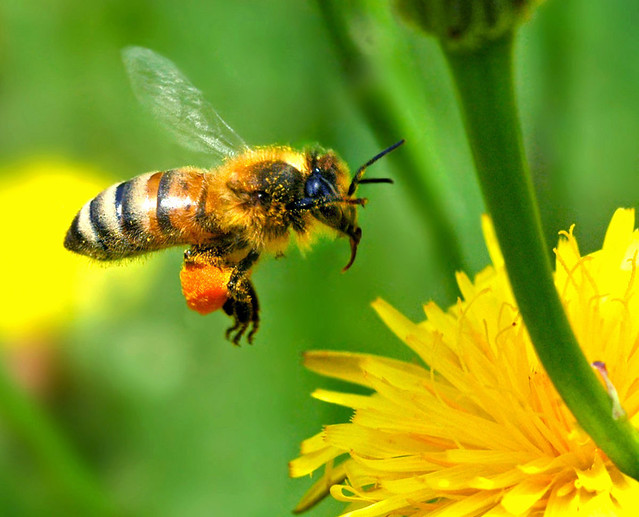By Anu Veijalainen, CABI. Reblogged from CABI Hand-picked blog.
Yesterday I cherished the start of spring in England by attending an event devoted to pollinators and pollination at the University of Reading. Most presentations at this meeting organised by the Royal Entomological Society were understandably about bees, but we also heard a few talks highlighting the importance of other pollinator groups.
For about five years now the media has been broadcasting alarming news about declining bee populations especially in Europe and North America. While the amounting evidence points to neonicotinoid insecticides being a major cause for the decline, I learnt yesterday that the situation is actually rather complex, other stressors are also involved, and scientists are still eagerly trying to form a complete understanding of the issue.
Multiple stressors threaten bee populations
The mysterious decline of bee populations has granted these insects a lot of press exposure in recent years – and rightly so; after all, pollinators provide a crucial ecosystem service. However, in the midst of following this growing information load, I realised that it was hard to keep up with the prevailing scientific consensus on the matter, especially on neonicotinoids. Therefore, I was glad to see that a review article summarising the current scientific evidence concerning the effects of neonicotinoid insecticides on insect pollinators intended to assist political decision-making was published at the end of last year. Another interesting review focusing on neonicotinoids and the prevalence of parasites and disease in bees came out earlier this month. Both reviews list a substantial number of recent studies indicating a connection between bee deaths and neonicotinoids.
New scientific case studies on bee health continue being published on a regular basis, and political and public discussion around bees and other pollinators remains active. This is demonstrated by searching for new records added to the CAB Abstracts database in the first four months of this year: using the searchstring ‘pollinator AND population AND decline‘ returns 25 results. Furthermore, last month the European Food Safety Authority (EFSA) launched a new website dedicated to bee health called #Efsa4Bees – Parasites, pathogens and pesticides: making sense of multiple stressors.
In conclusion, keeping up-to-date with the advancements in the field is challenging because there is a large amount of new information being produced and the studies have found somewhat conflicting results, i.e., indicating that bees are in decline due to a number of factors including pesticides, habitat loss and diseases. All these topics were also covered in the presentations given yesterday at the meeting ‘Progress in pollination and pollinator research’.
Potential for a brighter future
Being concerned about the current state of bee and other pollinator populations, I felt a sense of relief entering the lecture hall yesterday and noticing that so many people – over 80 mainly UK-based scientists attending this one-day event – have dedicated their careers to understanding and conserving pollinators. A number of the studies presented at the event had investigated how diverse bee communities can be supported in different landscapes, reflecting the fact that pollinators are also threatened by agricultural intensification and other human-induced land use changes. My day, however, culminated towards the end of the last session when excellent talks were given on the effects of insecticides on bees.
In her expert presentation, Dr Linda Field of Rothamsted Research first explained why neonicotinoids had become such efficient and commonly used insecticides in agriculture. She then moved on to state that in her opinion, blaming neonicotinoids for bee population declines was fairly “easy” (compared to, e.g., diseases and adverse weather events) yet hard to prove, and closed the talk by expressing what she thought was needed of pest management in the future. She highlighted the encouraging progress made in two areas of research: first, understanding how insecticides interact with target proteins and the variation of these proteins in different insects, and second, how insecticides are detoxified by insects and the variation of these mechanisms in different insects.
According to Dr Field, future pest management strategies should apply, for example, biological and cultural control, pest-resistant crop plants, and pesticides that specifically affect target pests but are not harmful for beneficial organisms.
Further activities for the concerned and the curious
If you’re interested in finding out more about the role of neonicotinoids in bee deaths, the AgriSciences group of the Society of Chemical Industry (SCI) is organising a topical one-day event titled ‘Are neonicotinoids killing bees?’ in London this September. Registration is now open.
Finally, I’d like to share a list of links to relevant news articles and scientific papers I’ve encountered in the last a couple of months. They represent only a handful of the articles out there, but demonstrate the somewhat conflicting messages of studies and the active work scientists are conducting on pollinator health.
- Bees are declining, IPBES report citing over 3,000 scientific articles says
- Where are the knowledge gaps in our understanding of neonicotinoid effects on bees?
- Exposure to neonicotinoids impairs crop pollination services provided by bumblebees
- Wild bee decline threatens US crop production
- Neonicotinoids harm individual honeybees, but whole colonies are able to recover
- What do pollinator declines mean for human health?
- Seeds treated with neonicotinoids produce higher soybean yields
- Rare long-term datasets clarify honeybee population fluctuation patterns in North America
- Human-driven trade of honeybees spreads a serious virus infecting hives
- Climate change a bigger threat to bumblebees than pesticides, reduces sizes of suitable habitats
- Non-bee pollinators also important, provide “insurance” against bee population declines
- Honeybees suffer learning and memory deficits after ingesting chlorpyrifos
- Bee flower choices altered by exposure to pesticides
- A total of 57 different pesticides found in European honeybees
References
Godfray HCJ, Blacquière T, Field LM, Hails RS, Potts SG, Raine NE, Vanbergen AJ & McLean AR (2015) A restatement of recent advances in the natural science evidence base concerning neonicotinoid insecticides and insect pollinators. Proceedings of the Royal Society B 282: 20151821.
Sánchez-Bayoa F & Desneux N (2016) Neonicotinoids and the prevalence of parasites and disease in bees. Bee World 92: 34–40.
1 Comment
Leave a Reply
Related News & Blogs
A new pesticide is all the buzz
Bees’ fuzzy yellow bodies and hairy legs are custom-built for picking up pollen. Nothing can distribute the yellow powder more efficiently—something farmers that shell out for commercial beehives every growing season know all too well. And starting with this fall’s growing season, bees may be given some cargo to carry on their outbound journey to the blossoms: pesticides.
22 October 2019





[…] Buzzing activity around pollinator health […]